Exhibition: "SEE THROUGH THE NOISE" by VII / 30.08.2024 / 19:00 / National Museum of Kosova
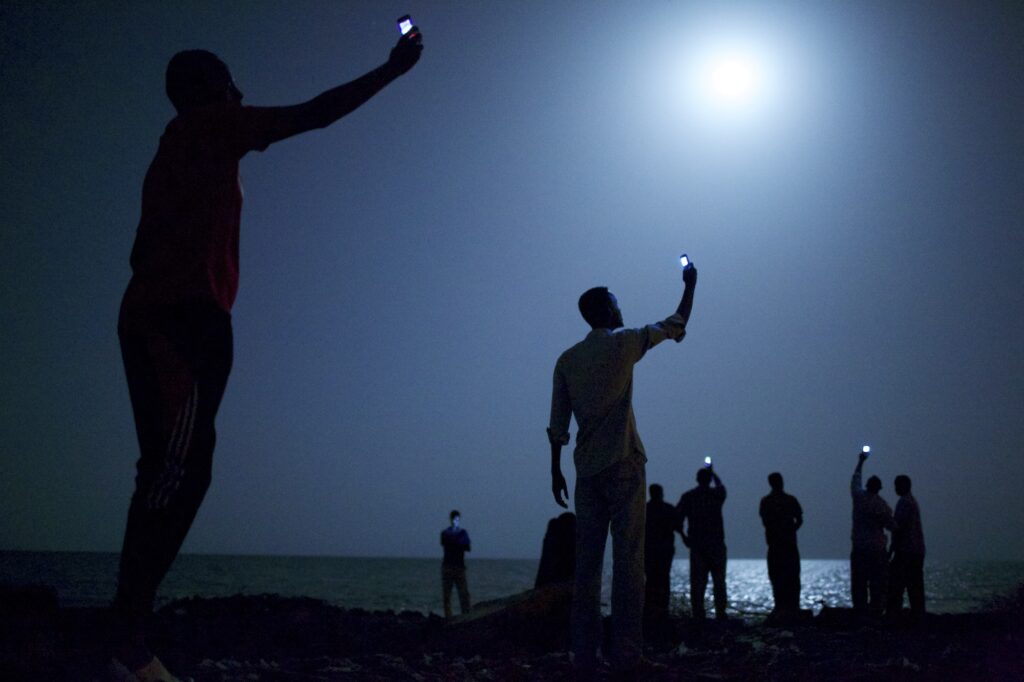
Photo: © John Stanmeyer / VII – African migrants on the shore of Djibouti City at night raise their phones in an attempt to catch an inexpensive signal from neighboring Somalia—a tenuous link to relatives abroad.
Exhibition: SEE THROUGH THE NOISE
Production & Curation: Ziyah Gafic / Gary Knight / Yonola Viguerie
The dawn of the digital era enabled the creation of VII on the 8th of September 2001. Three days later, Al Qaeda attacked the United States. In the following months, while the burning dust of the Twin Towers still choked New York, all seven founding members documented the violence that followed. In the ensuing years, as the narrative of the new century was being written, they photographed the invasion and occupation of Iraq, the wars in the Middle East, and the chaos that smothered an unjust world. The name VII became synonymous with courageous and impactful photojournalism.
VII went small and photographer-owned. The photographers believed in the power and energy of intimate collective effort at a time when corporations were acquiring smaller photo agencies and consolidating what had been a rich and diverse ecosystem into giant conglomerates. VII was created to give its members independence and enhance their ability to work on stories that mattered in partnership with the world’s leading press. It created new opportunities the photographers could not imagine. But the digital revolution that enabled the growth of VII also precipitated a catastrophic loss in revenue for its clients in the press.
Photojournalism means taking risks; it requires initiative, resourcefulness, empathy, and courage. It also involves trust, imagination, collaboration, and partnership. Publications and the photo agencies that served them were once essential partners in the life of a photojournalist. But trying to sell the news to a public that expects it for free means the press has fewer resources to deploy independent photographers and commission original work. Consequently, the media and photo agencies now have less impact and influence on the production of visual journalism. So, what next?
Anticipating the shrinking space the media would occupy in the lives of photographers, The VII Foundation was created to innovate and lead in the non-profit arena, unlimited by the constraints of the editorial marketplace. One of its objectives is to train and support photographers as they continue scrutinizing a world in turmoil and hold those who crave power to account. Ours is a world where leaders regard facts as optional, human rights as an inconvenience, and where it is increasingly difficult to differentiate between artifice and truth. Even the word truth is hard to explain — and is best defined by being the opposite of something — falsehood.
This was the first collective exhibition by VII in Arles, marking the acquisition of VII Photo by The VII Foundation in 2023. The featured photographs are among the most significant images depicting the events and issues they portray. They serve as an enduring testament to the importance, within our fragile societies, of a bold form of journalism that is free of artifice and falsehood — a pillar that is essential to The VII Foundation.
Encompassing photography bearing witness to historical events and critical review, selected work includes photography by:
Some of these works received the most coveted prizes in photography, such as World Press Photo of the Year, and were featured on pages of leading publications such as TIME magazine, National Geographic, Le Monde, The New York Times, Pari Match, others led to investigations to war crimes in Iraq and were used as court evidence in International Criminal Tribunal for the former Yugoslavia.
Exhibition: "BEHIND THE VEIL" by Barry Lewis
/ 30.08.2024 / 19:00 / National Museum of Kosova
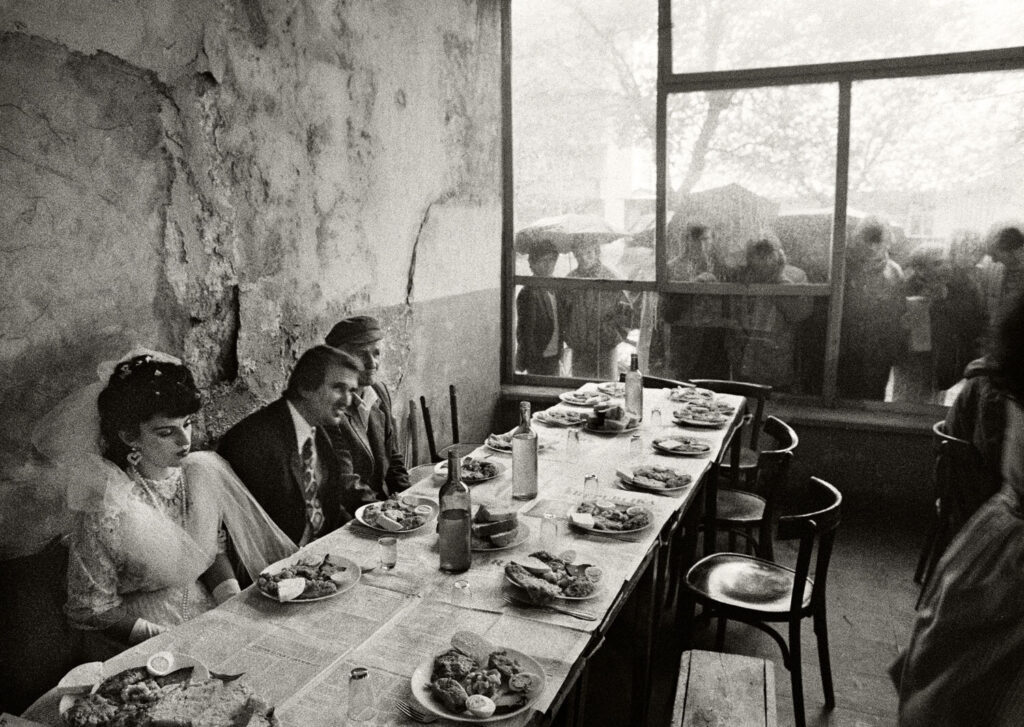
Photo: © Barry Lewis
Exhibition: BEHIND THE VAIL by Barry Lewis
Albania through isolation and transition
“Oh, we’re back in the Balkans again, back to the joy and the pain. What if it burns or it blows or it snows? We’re back to the Balkans again. Back, where tomorrow the quick may be dead, With a hole in his heart or a ball in his head. Back, where the passions are rapid and red, Oh, we’re back to the Balkans again!”
Song of the Balkan Peninsula, Edith Durham, 1908
In the 1970’s, along with half of my generation, I believed that socialism was the way forward and made photographic journeys to the USSR, Cuba, East Germany and Romania. Strangely the country that exerted the strangest charm for me, without my having visited it, was Albania. Tales of a closed country, following an isolated Stalinist path of socialism, then turning its back on the Eastern bloc and embracing Maoism, was always fuelling my imagination. The hum and whistle of Radio Tirana with its flat monotonal commentary and its mix of martial and folk music triggered visions of a secret land behind mist-covered mountains. The excesses of the capitalist world vision epitomized by “Voice of America” had lost any allure for me, and a secretive country which banned beards, pornography, Americans, and idolised Norman Wisdom cried out to be visited.
In 1990 I joined a group of twelve people, made up of spies, tourists, journalists, a retired farmer, a botanist and a rock musician, on an “archaeological study tour”. Between us we had about four words of Albanian, a 1960’s phrase book and a lot of fear, especially as the timing of the visit followed hard on the heels of the fall of the Berlin wall and fighting had just started in Kosova. We were taken from co-op to commune, listened to traditional folk singers and as a grand finale visited the Enver Hoxha state tractor factory (devoid of tractors). Between the lines, however, we could see a country in its death throes. People whispered at night of demonstrations and unrest, asking endless questions about the West and… Norman Wisdom.
We were one of a few groups to visit Shkodra and made a limited trip to the north where, in the inaccessible mountains, a way of life had resisted forty years of repression. Here in these isolated heights, village and tribal life was based on the Kanun, a rigid set of codes from medieval times, based on honour and blood. My interest was whetted, fed by fantasy and reading Edith Durham’s accounts of living with the “Mountaineers” in her book, ‘High Albania’.
President Hoxha died in 1985 and in a wave of riots signalling the end of the one-party state, his statue was toppled on 21st February, 1991. I returned to the country with the writer Ian Thompson in March as the mountain snows melted and access to the northern mountains became possible. The area had been closed to foreigners for forty years as Hoxha’s party control had encountered real problems with the fiercely independent population of the region. The journey, this time, was better organised. It needed to be. The country was in a state of anarchy and navigating our way on the difficult roads, anger and crime were a constant reminder of life as it had been. We were lucky to be some of the first Westerners to meet the generous people of the highlands who took us into their homes and fed us despite severe shortages. People followed their law “Our house belongs to God and guest” and we were always under the host’s protection and given both food and gracious company. When we came upon the mournful funeral of a young man in the village of Kalimash, way up in the mountains, not only did they let a stranger photograph a painful and deeply personal ritual, but we were taken to the father’s house where gifts of food were thrust on us, with the words: “We are so sorry. It is our custom to place a roasted sheep on the table in front of guests. But we don’t have the means anymore.”
Europe was changing at an unprecedented pace, through technology and the free flow of people, this corner of the Balkans was moving from a closed society, full of dark secrets and fierce bravery on it’s difficult and journey towards a new beginning.
I hope this work honours these people!
BARRY LEWIS
Barry Lewis started as a chemistry teacher with photography as a hobby. Barry stopped teaching in 1974 when he won a scholarship to the Royal College of Art where he studied under Bill Brandt. In 1976 he won the Vogue award and worked for a year with the magazine. In 1977 he received an arts council grant to photograph commuting in London, which was exhibited in the Museum of London and the Southbank. In 1981 & 83 he was exhibited in the Photographers Gallery, for ‘New Work on Britain’ and a solo show, ‘A Week in Moscow’ Working mainly for magazines, in 1999 he was a co-founder of the photo agency Network which played an important role in British Photojournalism for over 20 years. A regular contributor to Life Magazine, National Geographic, and the Sunday Times, Barry has worked globally until 2014 and made over 20 books. He has exhibited throughout the world and received several awards including the Leica medal for humanitarian photography. From 2015 for 5 years Barry worked mainly on documentary films but has returned to photography in 2021 when he started his current work, “Intersections”: a study of London through portraits and words of the people.
Exhibition: "BORN FREE – Mandela’s Generation of Hope" by Ilvy Njiokiktjien / 30.08.2024 / 20:00 / National Museum of Kosova /
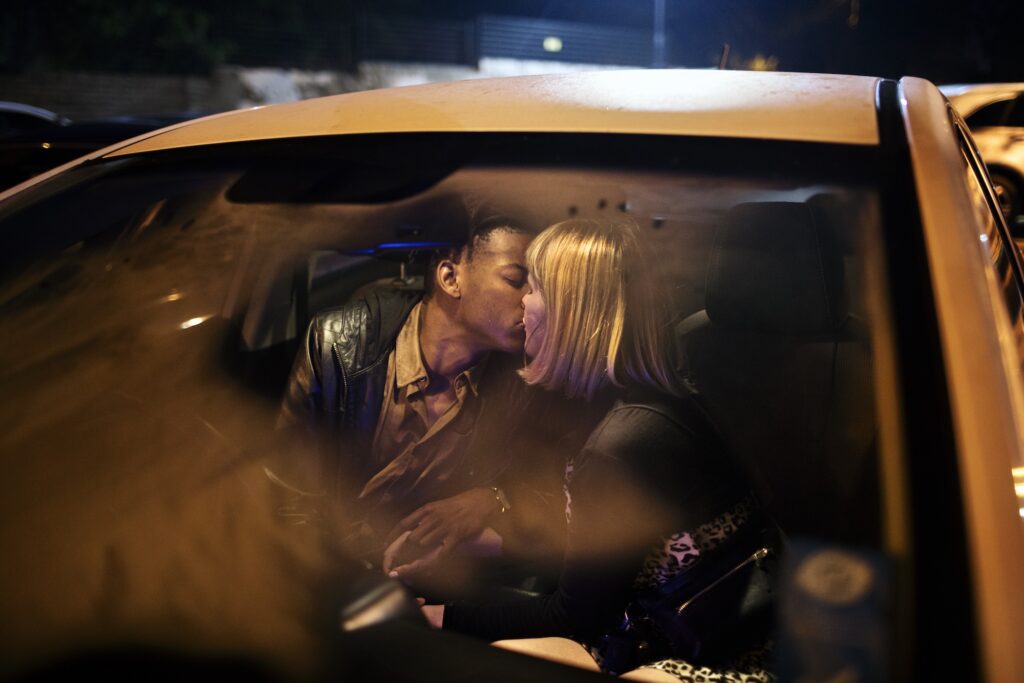
Photo: © Ilvy Njiokiktjien – VII / Wilmarie Deetlefs, 24, together with her boyfriend, Zakithi Buthelezi, 27, on a night out in Johannesburg, South Africa on Nov. 1, 2018. They are both part of South Africa’s ‘born free generation,’ youngsters who were born around the ending of the racial segregation system, apartheid.
EXHIBITION: “BORN FREE – Mandela’s Generation of Hope” by Ilvy Njiokiktjien
Production & Curation: Ziyah Gafić
Born Free – Mandela’s Generation of Hope by Ilvy Njiokiktjien opens at National Museum of Kosova, Prishtina, Kosova, on August 31st, 2024.
This year marks the thirtieth anniversary since Nelson Mandela became president of South Africa, initiating a new chapter for the country. This spring, elections are being held in South Africa, and for the first time in 30 years, polls indicate that the ANC (African National Congress) may not be the largest party.
Since 2007, VII Photo contributing photographer Ilvy Njiokiktjien has chronicled South Africa’s first post-apartheid generation. She became intrigued by these young adults and has followed the stories of more than 30 so-called ‘Born Frees’, portraying their daily lives in her distinctive and intimate style. The work provides insight into a generation trying to find their way in a country where apartheid no longer exists but a long history of exclusion and discrimination has not simply disappeared. “Equality is there on paper, but a majority of young people believe the legacy of centuries of inequality is still there.”
Born Free — Mandela’s Generation of Hope is a documentary, interactive website, book, and traveling exhibition.
ILVY NJIOKIKTJIEN
Ilvy Njiokiktjien (1984) is a photojournalist and filmmaker who has been creating and sharing stories for nearly two decades. Ilvy is based in Utrecht, the Netherlands, and she is a contributing photographer to VII Photo. Ilvy Njiokiktjien is committed to documenting the social and political issues that shape our world. Her work is characterized by a sensitive eye and a compassionate and personal relationship with her subjects. Her background, growing up in the Netherlands as a child of Dutch and Chinese Indonesian parents, played a role in this.
In addition to long-term projects like Born Free, Njiokiktjien teaches masterclasses, lectures, and extended lesson programs to young professionals, and she hosts podcasts. Clients include National Geographic NL, ICP (New York), The VII Foundation, and Canon. Njiokiktjien studied at the School of Journalism in Utrecht. Part of this period she spent abroad at Rhodes University in Makhanda, South Africa.
Exhibition: "LAST SEEN" by Hrair Sarkissian / 30.08.2024 / 17:00 / Grand 5th Floor /
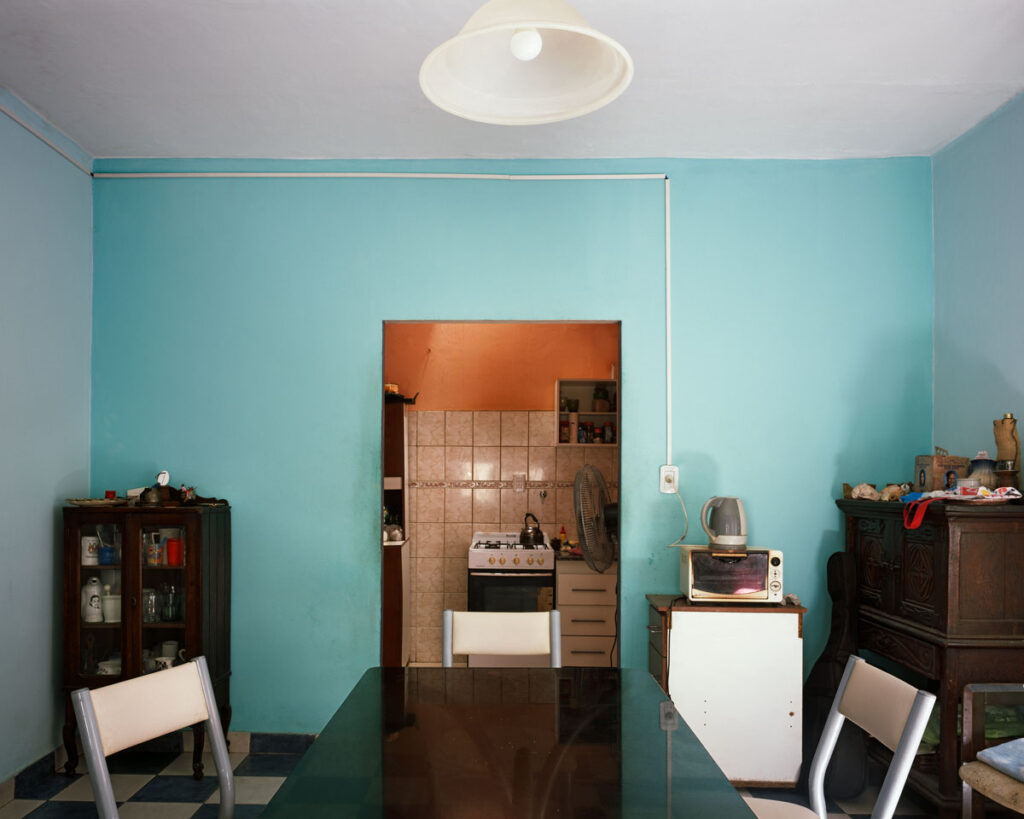
Photo: © Hrair Sarkissian
EXHIBITION: “LAST SEEN” by Hrair Sarkissian
Suported by: FOTOIST & Forum ZFD
Last Seen deals with the ambiguous loss that occurs when people disappear during times of war or civil unrest. Without any clear evidence proving death, the ones left behind are unable to grieve, holding on to the chance of their missing loved ones returning.
The photographs are of the place where the missing person was last seen by their families. Each frame is furthermore embossed with the disappeared person’s name and the year they vanished. There is a fine line between presence and absence in these locations, embodying the notion that these events are memorized in the physicality of a space. Each picture in turn functions as an anti-monument and archive for the victims and their families. The project was realized in Lebanon, Brazil, Argentina, Kosovo and Bosnia.
HRAIR SARKISSIAN
Hrair Sarkissian earned his foundational training at his father’s photographic studio in Damascus. He is considered one of the leading conceptual photographers of his generation. Spanning photography, moving image, sculpture, sound and installation, Sarkissian’s practice creates meditative dreamscapes in some moments; deathscapes in others—sites where the muted voice, absent from the frame, is temporarily offered space to breathe.
Sarkissian is on the Advisory Board of the Arab Image Foundation in Beirut. His 2020 exhibition at The Modern Art Museum of Forth Worth, curated by Dr. Omar Kholeif, was the first solo exhibition of a Syrian artist in the United States. Selected recent exhibitions include the British Art Show 9, the 14th Sharjah Biennial, the Brighton Photo Biennial, the Sursock Museum in Beirut, the Imperial War Museum in London, the Baltic Contemporary Art Centre in Newcastle, the 10th Bamako Encounters African Biennial of Photography, the Armenian Pavilion at the 56th Venice Biennial (awarded the Golden Lion), Tate Modern in London, the New Museum in New York, and the Mori Art Museum in Tokyo.
His mid-career survey exhibition opened in October 2021 at the Sharjah Art Foundation, and toured to the Bonniers Museum in Stockholm (2022) and the Bonnefanten Museum in Maastricht (2022/23). The exhibition brought together two major new commissions and more than a dozen of his most significant bodies of work from the preceding 15 years.
Exhibition: "KEEP CALM AND SMILE" by Korab Basha / Curated by Elton Koritari
/ 30.08.2024 / 19:00 / National Museum of Kosova
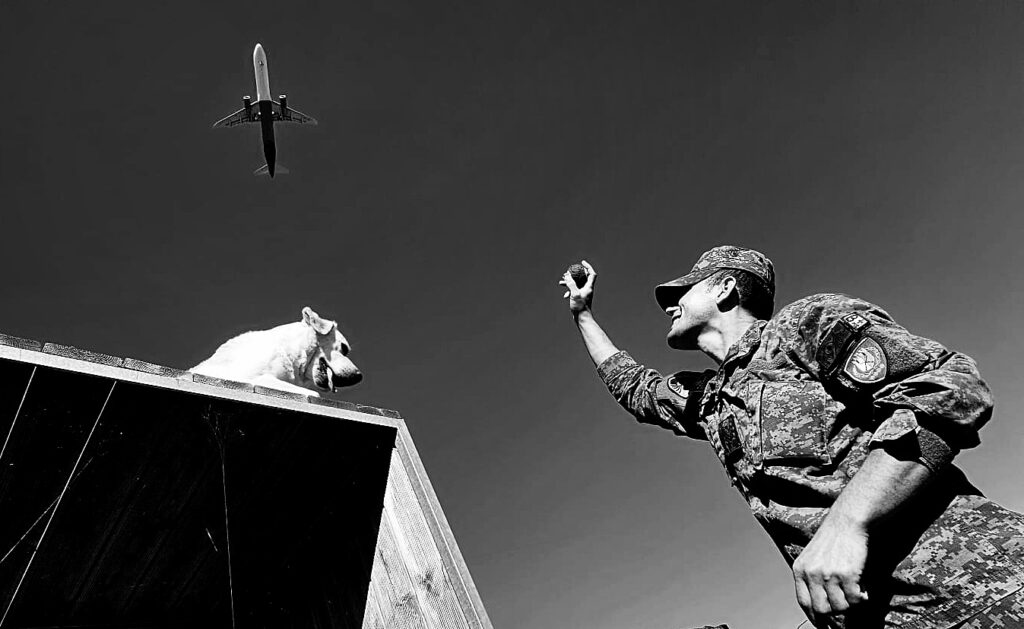
Photo: © Korab Basha
EXHIBITION: “KEEP CALM AND SMILE” by Korab Basha / Curated by Elton Koritari
“QËNDRO I QETË DHE BUZËQESH” nga Korab Basha / Kurator: Elton Koritari
Titulli i këtij projekti ambicioz të fotografit Korab Basha, fjalë për fjalë mund të përkthehet “Qëndroni të qetë dhe buzëqeshni”. Basha ripërdor dhe riinterpreton sloganin e ushtrisë së Mbretërisë së Bashkuar i cili gjatë luftës së dytë botërore motivonte britanikët për të qëndruar të qetë dhe për të vazhduar, për të ecur, për të mbajtur gjallë optimizmin, pavarësisht kërcënimit të afërt të pushtimit nazist. Madje, edhe pse nuk u publikua kurrë në atë kohë por u rishfaq pas më shumë se 50 vitesh, ky slogan, me një rikthim triumfal në pop-kulturën bashkëkohore, vazhdon të jetë një simbol i fortë i rezistencës dhe durimit në përballje me sfidat e jetës, jo vetëm në aspektin propagandistik të tij. Në stuhinë e vazhdueshme të tensioneve ushtarake dhe politike, sot ushtria e Kosovës mishëron dhuntinë e të qendruarit në ballë të vendit dhe e bën këtë duke u mbështetur fort në humanizmin e saj.
FSK është një ushtri e qytetarëve të saj dhe kjo gjë paraqet një moment historik dhe të rëndësishëm në afirmimin ndërkombëtar të shtetit të Kosovës. “Keep Calm and Smile” thekson qëndrueshmërinë, integritetin moral dhe mbështetjen e fuqishme në popull të forcave të armatosura dhe simbolizon kështu një qasje të guximshme ndaj sfidave të Kosovës bashkëkohore. E akoma më shumë, në këtë ekspozitë, ata me buzëqeshjen e tyre përfaqësojnë forcën dhe krenarinë e popullit shqiptar në përballje me çdo sfidë, ashtu si përherë në historinë tonë. Vajzat dhe djemtë që mbushin sot rreshtat e kësaj ushtrie, janë pasqyrë e të gjithë kosovarëve që duan të lënë pas të kaluarën dhe në fund të shikojnë nga e ardhmja. Me një buzëqeshje.
FSK është e qartë si dielli se nuk ekziston për të sulmuar askënd, përkundrazi ajo vetëm mbron integritetin dhe pavarësinë e Republikës së Kosovës, ngritur mbi bazat e rezistenzës dhe qëndresës së Ushtrisë Çlirimtare, e cila lindi pikërisht për të mbrojtur njerëzit e saj të të masakruar prej dekadash, të lodhur nga një e kaluar mizore dhe të dërrmuar nga mohimi i parimit të vetëvendosjes. Sot, qytetarët e Kosovës, në shtetin e tyre të fituar me vetëmohim dhe sakrificë, ndjejnë më shumë se kurrë dëshirën për ta mbyllur me të shkuarën dhe më në fund të shikojnë të ardhmen drejt në sy, larg dhunës, të lirë. Me një projekt të qartë në vizionin e tij dhe me këmbëngulje të admirueshme për ta realizuar atë deri në fund, Korab Basha na tregon jo vetëm sesi ushtarët e Kosovës shohin pra nga e ardhmja, pikërisht ashtu siç ndihet dëshira për të ardhmen në zemrën e çdo qytetari kosovar por edhe se pas shumë vitesh ndërhyrjesh të çmuara nga ushtritë e huaja, është një arritje e madhe për Kosovën që të ketë një ushtri të sajën dhe më shumë se kurrë ta shijojë këtë simbolikë të vogël, por të madhe. Artisti hyn thellë edhe në kontekste më globale sesa trevat tona. Ai na sugjeron se në fund të fundit, paqja fillon me një buzëqeshje.
Exhibition: "HOUSE FOR SALE" by Imre Szabó
/ 31.08.2024 / 19:00 / Barabar Centre - Grand 4th Floor
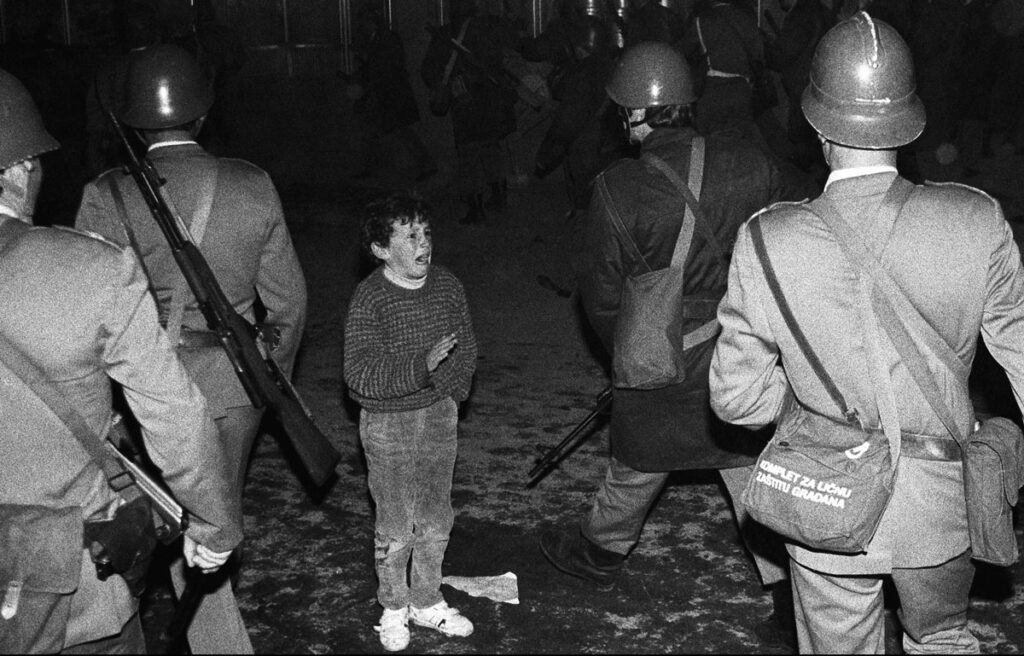
Photo: © Imre Szabó – Protests in Ferizaj 1989
EXHIBITION: “HOUSE FOR SALE” by Imre Szabó
“Kid, it’s a mess down there, but don’t just capture all the bad and broken stuff. Capture something we can use to illustrate texts.”
These were the words that Mirko Bojić, the then editor-in-chief of “Illustrated Politics,” used to see off Imre Szabo ahead of his first photographic assignment in Kosovo in 1981. He was probably unaware that, by sending him, he was doing an extremely significant thing for the creation of one of the most important photo archives of Kosovo from 1981 to 1999.
“When we published the photograph and the story House for Sale about how Serbs were selling their property and leaving Kosovo, I did not expect such reactions at all. We stumbled upon a grandmother completely by chance, sitting under a tree and peeling potatoes, and there was a sign “House for Sale” on the tree. After that, the same night, we visited Branko Đurica, then the deputy editor-in-chief, to tell him about that conversation. He immediately called the editor-in-chief and said we are changing the cover. This is how the photograph and the story ended up on the cover. It was all this strange to me. When the story came out, we were attacked from Serbia, being asked what we were doing and why we were stirring up the people.
“When Milošević went down there, I was convinced that he was really going to calm things down, that he had sincere intentions. However, when I attended those meetings and rallies, it became clear to me that nothing of that sort was happening.”
“Ever since I learned to speak Serbian, I haven’t had any problems based on nationality in Yugoslavia. This is why some things that awaited me in Kosovo were completely unimaginable from my perspective.”
Born in Mokrin, Serbia, in 1956, Imre completed high school in Kikinda and studied German Language and Literature at the Faculty of Philology, Belgrade University. He has been publishing photos since 1974 and has participated in over 200 exhibitions both domestically and internationally, earning numerous awards. His solo exhibitions have been held in Kikinda, Mokrin, Skopje, Belgrade, Banatski Brestovac, Ankara, Maribor, Paraćin, Kragujevac, Niš, and Istanbul.
He contributed to the “Light and Shadows on the Balkans” exhibition with 10 photos, displayed in Belgrade (2009), Bucharest (2010), Istanbul (2010), and Ankara (2010). He also participated in the “Lessons from ’91” project (2016 and 2017), which was exhibited in Zagreb, Belgrade, Berlin, and Maribor.
A professional photographer since 1980, Szabó began his career as a newspaper photographer at “Ilustrovana Politika” until 1989. He briefly worked at the daily newspaper “Politika” before moving to “Intervju” until autumn 1991 and then to “Nin” until 1995, after which he pursued applied photography independently. He has also served as a photography editor at the daily newspaper Danas, the weekly magazine Blic News, Novi magazin, Status monthly magazine, and for the news agency Fonet.
His work has been published in numerous significant international journals such as Stern, Focus, Spiegel, Mond, Lexpress, Time, Newsweek, Herald Tribune, and Le Nouvell Observateur, as well as in most Yugoslav newspapers and many monographs, catalogues, and publications.
He has been a member of ULUPUDS (Association of Serbian Applied Artists) since 1985 and is currently a freelance photographer based in Belgrade, Serbia.
Exhibition: "CONFLICT'S EFECTS" by Armando Babani / Curated by Elton Koritari 31.08.2024 / 19:00 / Barabar Centre - Grand 4th Floor
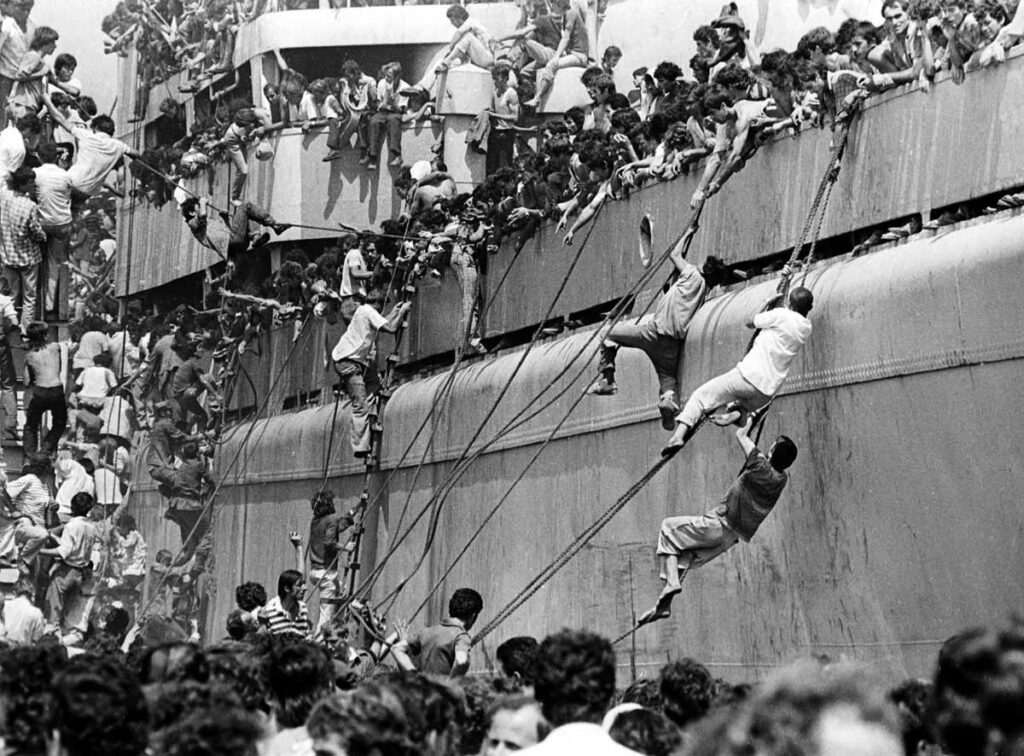
Photo: © Armando Babani
EXHIBITION: CONFLICT’S EFFECTS” by ARMANDO BABANI – Curated by ELTON KORITARI
The concept of this exhibition is to offer to the public of FOTOIST – International Photography Festival a glimpse into the instability of the contemporary world – more namely the possibility of examining long term consequences of conflicts on Albanian society, with particular emphasis on scars and the transformations that merge over time. The exhibition also explores the way that the work of the photographer’s documents traces persistently the conflicts in daily life, relationships and in social dynamics. It offers so, through the living example of the Albanian history, the opportunity to explore and understand complex facets of global society, projected into everyday life – to understand, precisely the daily life in Buca, the drama of the Middle East, the refugee crisis, the great geopolitical tensions, the human condition in the post Covid19 era, the climate crisis with its extreme climatic events and why not, the suburbs, the social disadvantage of our young people and our elderly people. Understand how images can become powerful tools complaint, drawing attention to situations of injustice or suffering. Understanding the roots of conflicts and instabilities, by searching to understand the underlying causes and their long-term impacts on society. Focusing on human resilience and stories of hope and courage that emerges even in difficult contexts.
“EFEKTE TË KONFLIKTIT” nga ARMANDO BABANI
Koncepti i kësaj ekspozite është t’i ofrojë publikut të FOTOIST – Festival Ndërkombëtar i Fotografisë një vështrim në brendësinë e paqendrueshmërisë së botës së sotme – më saktësisht, kjo ekspozitë na jep mundësinë për të shqyrtuar pasojat afatgjata të konflikteve në shoqërinë tonë, me një theks të veçantë në transformimet dhe plagët që shfaqen në kohë. Ekspozita gjithashtu eksploron mënyrën se si puna e fotografit dokumenton gjurmët e vazhdueshme të konflikteve në jetën e përditshme, në marrëdhëniet dhe dinamikat shoqërore. Më gjërësisht, ekspozita i ofron publikut të Kosovës – përmes shembullit të historisë 40-vjeçare të Shqipërisë – mundësinë për të eksploruar dhe kuptuar ndërfaqet e ndërlikuara të shoqërisë globale, të projektuara në jetën e përditshme. Për t’i ndihmuar pra pse jo të kuptojnë çfarë fshihet pas kompleksitetit në ngjarje si ajo e Buçës, ato në Lindjen e Mesme, krizën e refugjatëve, tensionet e mëdha gjeopolitike, gjendjen e njerëzimit në erën pas Covid19, krizën klimatike me ngjarjet e saj ekstreme dhe pse jo, periferitë tona, mjerimin shoqëror të rinisë dhe braktisjen e të moshuarve tanë. Për të kuptuar se si imazhet mund të bëhen mjete të fuqishme për të denoncuar, për të tërhequr vëmendjen drejt situatave të padrejta dhe vuajtjeve të çdo individi. Për të treguar rënjët, gjenezat e konflikteve dhe instabilitetin e kohës tonë, duke u përpjekur njëkohësisht për të hulumtuar shkaqet themelore dhe ndikimet e tyre afatgjata në shoqëri. Dhe akoma më shumë, duke u përqëndruar në reziliencat humane dhe historitë e shpresës dhe guximit që dalin edhe në kontekste të vështira.
An ‘imprisoned’ child from the flood, with a terrified look, behind the bars of a window; the artist Edi Rama hooded like a rebellious teenager in front of a plate stuffed with tomato pasta; Schumacher exhausted at the end of a race; The Monument of the former dictator falling violently into the crowd, thousands of ropes hanging from the edge of a ship where desperate people climb, they leave their own country. This is also the face of the photography of Armando Babani, or rather say, it has thousands of faces, faces that make up history, of the last four decades. We all grew up with his images, he has told all of us the truth about him in the course of years, cyclically, has always coincided with the truth of History. Multifaceted, unique, iconic, international photo reporter – published everywhere in the world – but also a photographer, the most important Albanian photojournalist, that never gets tired and carries on impersonating a critical observer and participant, contributes to give voice to those who could otherwise be ignored and stimulating reflection on complexity of our ever-changing world. As a photojournalist, published all over the world but even as an endaged artist, Armando Babani carry on a mission from almost 40 years, as he say it: “To only photograph the world, without altering the story”.
Exhibition: "THE ARK OF MEMORY" - Curated by: Ardian Isufi and Lindar Muça
/31.09.2024 / 17:00 / GALLERY OF ART'S ACADEMY /
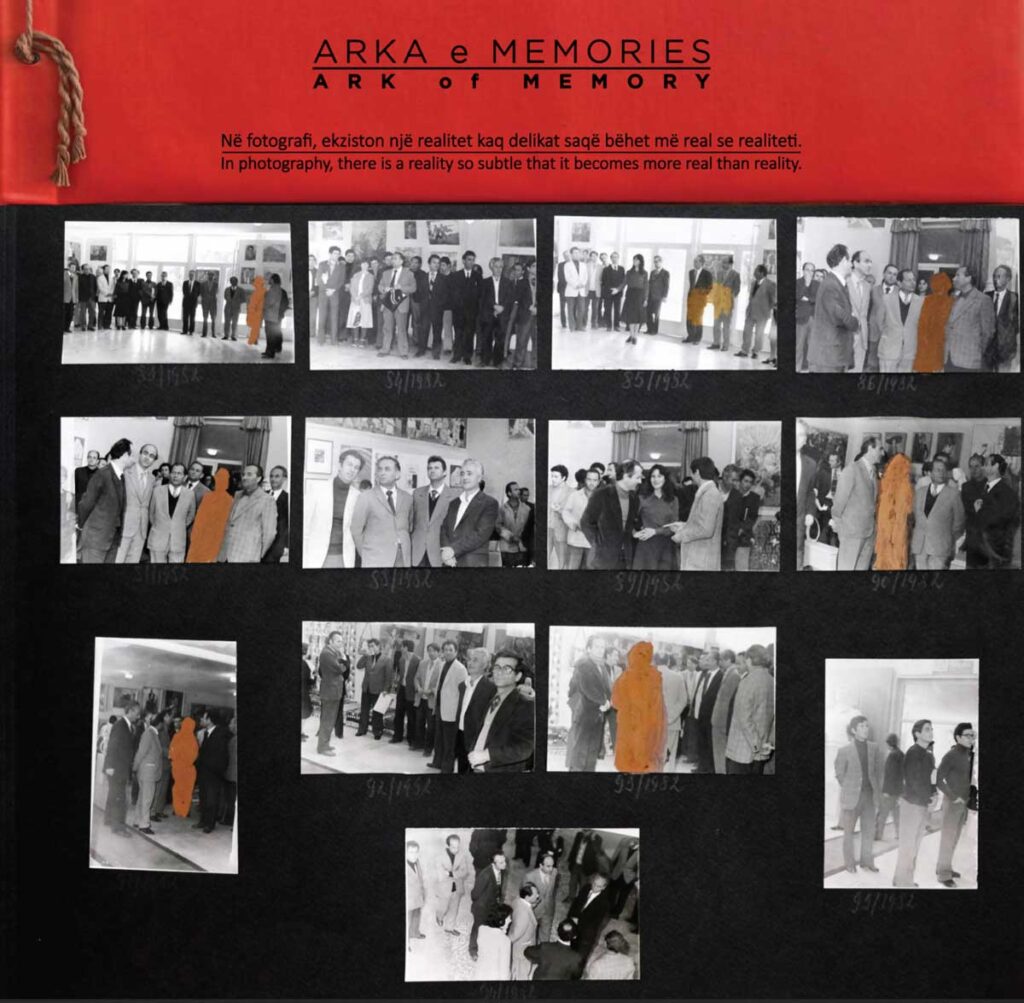
Photo: © FAB
EXHIBITION: “THE ARK OF MEMORY” – Curated by: Ardian Isufi and Lindar Muça …wandering through the narrow book-filled corridors of the University of the Arts Library to find art memoirs as an extension of our modest research, to know and understand more cultural subfields such as human anthropology and cultural phenomenology, we were stunned in front of a stack of old photo albums, where browsing them from the dust of the past, immediately leads you to the traces of the visual archive of the High Institute of Arts (today the University of Arts – UART).
“In photography, there is a reality so subtle that it becomes more real than reality” – Alfred Stiegliz
Images are worth a thousand words, the traces of light on celluloid has forever marked university life, in school events so in the characters of the professors, students, artists and the many who have contributed over decades to create the elites in education and culture of Albania. From the “Ark of Memory” the light and shadows of the utopian times we lived in, between the revolutionary spirit and historical retouches, can be clearly distinguished!
About the Faculty of Fine Arts and the Library of the University of Arts Tirana:
The Faculty of Fine Arts (FAB) at the University of Arts is the most important institution for the professional artists and artistic pedagogy in Albania. Founded in 1959 with a 65-year academic tradition, FAB is the only public higher education institution of arts. The Library of the University of Arts is the largest and oldest art library in Albania. It is a university library that directly helps in the formation of young artists in Albania.
ARKA E MEMORIES Kuruar nga: Ardian Isufi dhe Lindar Muça
…duke rrugëtuar nëpër koridoret e ngushta plot libra të Bibliotekës së Universitet të Arteve për të gjetur memuare të artit si zgjatim i hulummeve tona modeste, për të njohur dhe kuptuar më shumë nënshtresëzimet kulturore si antropologji njerëzore dhe fenomenologji kulturore, ngelëm të shtangur përballë një pirgu me albume të vjetra fotografike, ku shfletimi i tyre nga pluhuri kohëve të shkuara, të kaplonte menjëherë në gjurmët e arkivës pamore të Instutit të Lartë të Arteve (sot Universiteti i Arteve – UART).
“Në fotografi, ekziston një realitet kaq delikat saqë bëhet më real se realiteti” – Alfred Stiegliz
Çdo imazh flet sa për një mijë fjalë, çdo gjurmë drite në celuloid ka shënjuar përjetësisht jetën universitare në aq shumë ngjarje shkollore, me personazhe të profesoriatit, të studentësve, artistëve e të shumë të tjerëve të cilët kanë kontribuar në dekada për të krijuar elitat në edukimin dhe kulturën e Shqipërisë. Nga “Arka e Memories” dallohen qartazi edhe dritë-hijet e kohëve utopike që jetuam, ndërmjet frymës revolucionare dhe retushimeve historike!
Rreth Fakultetit të Arteve të Bukura dhe Bibliotekës së Universitetit të Arteve Tiranë:
Fakulteti i Arteve të Bukura (FAB) në Universiten e Arteve është instucioni më i rëndësishëm i formimit të arstëve profesionistë dhe pedagogjisë artistike në Shqipëri. I themeluar në vitin 1959 me një traditë akademike 65-vjeçare, FAB është i vetmi instucion i arsimit të lartë publik në fushën e arteve. Biblioteka e Universitet të Arteve është biblioteka më e madhe dhe më e vjetër e artit në Shqipëri. Ajo është një bibliotekë universitare që ndihmon në mënyrë të drejtpërdrejtë në formimin e artistëve të rinj.
Artist with a long career in the contemporary art scene, art critique continuously involved in organizing artistic activities and curating exhibitions. As an artist, he has participated in many national and international artistic activities in various countries such as Italy, Greece, France, Austria, China, United States etc., Where among others is worth mentioning; Tirana Biennale 2009, Venice Architecture Biennale in 2018 as an artist invited by the Albanian Pavilion, participant and winner of the third prize in 2005 and second prize in 1996 at the “Onufri Prize” the Albanian International Visual Arts Competition, etc. As a curator and art critic, his work is wide-ranging, the artist best represents the generation of Albanian artists and intellectuals actively engaged transversely all the spectrum of public action. In his work, Ardian Isufi has established a constant relationship with the Albanian public, as an artist or curator, always trying to confront public with acute social problems, always investigated from a contemporary and global point of view.
Exhibition: "CHRONICLE OF FADING STORIES - Kosova 2010-2012" by Eni Nurkollari
/ 02.09.2024 / 19:00 / Kosova National Library /
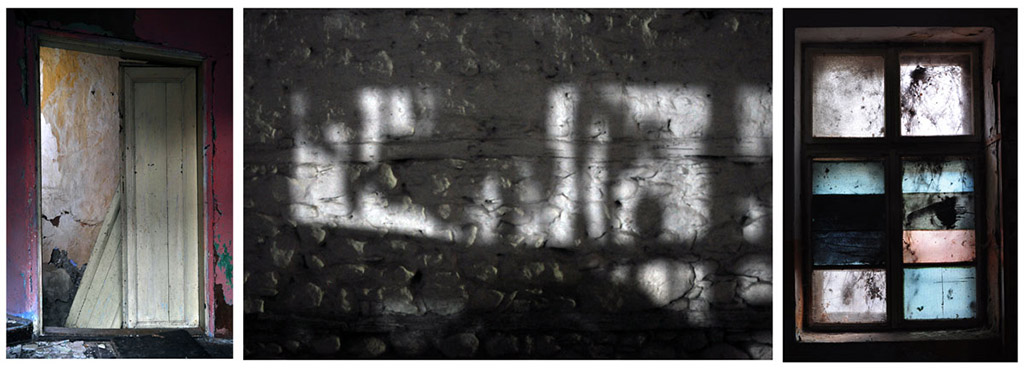
Photo: © Eni Nurkollari
EXHIBITION: “CHRONICLE OF FADING STORIES – Kosova 2010-2012″ by Eni Nurkollari
After living abroad for 23 years, returning to Kosovo in 2010 meant finding dynamic changes going on, as a result of the transition the country was going through.
Searching for what he called home, the photographer found himself capturing a thin line from the past and trying to make it continue. Many houses, schools, and spaces that were once full of life, were now barely standing in some sort of a time vacuum. Some spaces were disappearing, some had lost their prestige and charm, while a few new ones were created by a minor group of people who were trying to revive what they once had.
Photographing during those two years, was like fighting against the time. It was an attempt to hold on to the fading monochrome memories and an effort to recall the colourful life stories that had flourished in those spaces before.
“KRONIKË TREGIMESH TË VENITURA – Kosova 2010-2012″
Born in Prizren, Kosova, in 1964, Nurkollari started working in his father’s photography studio at the age of twelve. There he learned dark-room techniques as well as field and studio photography. From 1985, he began creating his first personal works. In 1986 and in 1987, despite being accepted to study in the Department of Photography at FAMU (Film and TV School of the Academy of Performing Arts in Prague, Czechoslovakia), he was prevented from registering officially by the Yugoslav administration. He went on working in fashion photography for the Art Design Models agency in Poreć, Croatia, between 1986 and 1988. He then moved to Germany and worked throughout the 1990s as a freelance photographer for the Stadtmagazin Augsburg and participated in Michael Jochum’s Projekt Fotografie at Münchener Volkshochschule from 1995 to 1998. In 2005, he opened “Atelier M” in Motovun, Croatia, where he explored digital photography and printing on different materials. His work illustrated the book “Toward a Short History of Motovun” (2010) by Ranko Bon. Nurkollari curated Espen Rasmussen’s photography exhibi
He lives in Tenerife since 2019, after spending five years in Barcelona, continuing to explore photography as a form of personal expression.
